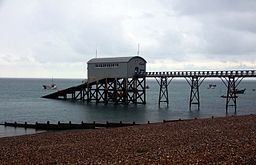 | ||
Similar Littlehampton Lifeboat Station, Southbourne railway station, Fishbourne railway station, Tenby Lifeboat Station, Emsworth railway station | ||
Gopro hero3 scuba diving selsey lifeboat station
Selsey Lifeboat Station is an RNLI station located in the town of Selsey in the English county of West Sussex in the United Kingdom.
Contents
- Gopro hero3 scuba diving selsey lifeboat station
- Map of Lifeboat Station Kingsway Selsey Chichester PO20 0DL UK
- Selsey lifeboat station demolished 15 jan 2016
- History
- References
Map of Lifeboat Station, Kingsway, Selsey, Chichester PO20 0DL, UK
The station operates a Tyne-class lifeboat RNLB Voluntary Worker (ON 1146) which is launched via slipway from the main boathouse which stands away from the shore on a piled platform. The station also operates a D-class (IB1) inshore lifeboat, RNLB Betty and Thomas Moore (D-691) which is kept in its own purpose built boathouse close to the approach gangway of the main station.
In 2017, Selsey is due to receive a new 25 knot (29 mph) Shannon-class lifeboat after almost 34 years of service by Tyne-class boats, easily the longest of any station.
Selsey lifeboat station demolished 15 jan 2016
History
The establishment of a lifeboat service in Selsey was in 1861 with RNLB The Friend; she was launched from the beach by means of skids. For the station's first 25 years the lifeboat's Coxswain was James Lawrence. On his retirement from the service in 1886 he was awarded a RNLI silver medal in acknowledgment of his long and valuable lifesaving service, highlighting rescues such as those of the brigs Governor Maclean (1875) and Sharah Ann (1871), the schooners Exel (1872) and Henrietta (1875), the barques Sueine Meinde (1878), and Tranmere (1883), and the schooner Kyanite (1881). In 1925 work began on the construction of a new boathouse built on a piled platform with a gangway leading to it from the shore. The gangway incorporated a trolley track. In 1927 the boathouse was once more re-built to enable it to house the station's new motor lifeboat.
During the Second World War the station had a busy time. The Watson-class lifeboat RNLB Canadian Pacific (ON 803) made many trips to rescue pilots from fallen aeroplanes and was launched on service 50 times. In one rescue on the 11 July 1940, the lifeboat saved the life of Squadron Leader John Peel, the commanding officer of 145 Squadron based at Tangmere. He was forced to ditch his Hurricane (P3400) into the sea off Selsey Bill after sustaining damage in a fight with German Bombers. Peel was in the water with just a Mae West life saving jacket, but he was pulled from the water by Canadian Pacific only minutes after ditching. Canadian Pacific remained on station until 1969 and records show that she went on 286 services and rescued 157 lives.
In 1952 and into 1953 the boathouse's substructure was improved and strengthened and the slipway was lengthened. In 1958 the boathouse was re-built as the old structure had become unsafe and unserviceable due to years of coastal erosion. The new station was built with reinforced concrete and the deep water roller slipway was re-configured to have a gradient of 1:5. The station was also given a new fabricated steel approach gangway from the shore.
In 1968 the service at Selsey was enhanced with the establishment of an inshore lifeboat rescue division. This new service started in March of that year with the new lifeboat kept in a boathouse located by the approach gangway to the all-weather boathouse. The inshore lifeboat was launched on a newly constructed gangway laid on the shingle beach to the eastern side of the main slipway. The first inshore lifeboat was a D-class lifeboat. Further improvements were made to the inshore service with the construction of a new boathouse in 1987, the new structure including a new crew room, storeroom and a souvenir shop.
In 2011 the station celebrated its 150 years as a continuously active lifeboat station. The occasion was marked by the RNLI by awarding the station as a whole an award on vellum which recognised the station's 150 years of dedicated service in the pursuit of saving lives at sea.
